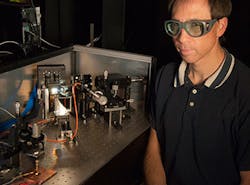Researchers at the National Institute of Standards and Technology (NIST; Boulder, CO) have developed an instrument built around a visible/IR supercontinuum laser that generates artificial sunlight to help test photovoltaic cell properties.1
The novel NIST system simulates sunlight accurately across a broad spectrum of visible to IR light. More flexible than conventional solar simulators such as xenon arc-lamps or LEDs, the laser instrument has an output that can be focused down to a spot with a size near the diffraction limit. The output can also be tailored to match any desired spectral profile.
Seeing microscopic material variations
The supercontinuum laser combines an optical-fiber amplifier with a photonic-crystal (PC) fiber that broadens the spectrum due to nonlinear optical processes (the standard setup for a supercontinuum laser). NIST researchers used the simulator to measure the efficiency of thin-film solar cells made of gallium arsenide (GaAs), crystalline silicon, amorphous silicon, and copper indium gallium selenide (CIGS), and the results agreed with independent measurements. As a result, the researchers could see material variations that were selectively excited and resolved on GaAs and CIGS cells.
"We can focus the light down to a spot less than 2 μm in diameter, despite the wide spectral content. You can't do this with sunlight," NIST researcher Tasshi Dennis says. "We then used this focused spot to scan across solar-cell materials while monitoring the current the light generated. This allowed us to create spatial maps (images) of the response of a solar cell at the micrometer level."
Dennis explains that the new instrument may help researchers understand solar cells' optical and electrical characteristics, including defects and the impact of unusual designs. In particular, the new simulator's capability to make rapid, accurate spectrum adjustments will help characterize the most-efficient solar cells, which use multijunction materials in which each junction is tuned to a different part of the spectrum.
The instrument is designed to probe small research samples, individual concentrator solar cells, and microstructures, not to determine the efficiencies of large solar-cell panels and modules. NIST researchers have been working to make the new simulator programmable and portable for use outside NIST.
Source: http://www.nist.gov/pml/div686/solarsimulator_052714.cfm
REFERENCE:
1. T. Dennis et al., IEEE Journal of Photovoltaics (2014) DOI: 10.1109/JPHOTOV.2014.2321659

